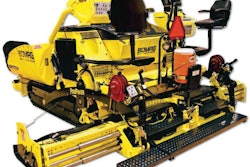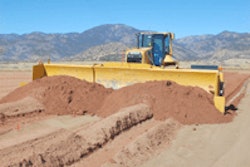After a 120-mph tornado ripped apart a wood-and-shingle facility just before winter, a fast-tracked replacement had a new covered dome up in time for the 2009-10 winter.
 The new INDOT LaPorte District Chesterton Unit salt dome is bigger than the unit building.
The new INDOT LaPorte District Chesterton Unit salt dome is bigger than the unit building.
“In consideration of the two 30-inch snows we had in the Chesterton area last year, it’s crucial to our traveling public to have salt easily accessible here,” says INDOT Highway Maintenance Director Stacy Flick.In a feat of great management and hard work, a new Cover-All salt dome was up and running in time for the 2009-10 winter season.
The LaPorte District’s first Cover-All dome was installed in 2003 at the Rensselaer Unit. However, he stretched fabric has ripped a couple times throughout the years, mostly on the seams.
Tom Kerkes, Rensselaer Sub-District Manager,
 A front-end loader is dwarfed in size by the new Indiana Department of Transportation LaPorte District Chesterton Unit salt dome.
A front-end loader is dwarfed in size by the new Indiana Department of Transportation LaPorte District Chesterton Unit salt dome.
said it has been extremely beneficial for the agency to have the convenience of having a door on each side of the Cover-All dome. “Trucks can now just drive through, rather than having to pull in and back out every time,” Kerkes says. “It’s also convenient that staff can load and unload salt inside the dome, as well as have room for keeping cold mix out of the weather.”
Kerkes says the new dome type has been so successful that all future INDOT salt domes will incorporate some of its elements.
“We’ve set a design standard in the Cover-All,” INDOT Facilities Manager Steve McAvoy says. “All future designs will be based off the type where we can load and unload inside, and have room for our brine-making systems.”
- The old INDOT LaPorte District Chesterton Unit salt dome fell onto its salt and a tractor-trailer parked nearby after losing a battle with tornado winds in August 2009.
INDOT District Operations and Traffic Management Deputy Commissioner Michael B. Cline noted that productivity has increased because of a larger dome’s storage capabilities.
“Larger capacity means fewer loads of salt must be trucked in,” he said.
“Also, any salt we’re able to store is money ahead for the next year,” Zier added.
Chesterton’s new dome has a capacity of 13,000 tons whereas the previous one had 5,400 tons.
The new dome allows room for more salt storage, truck-washing and brine-making stations, as well as a place to keep winter asphalt out of the weather and workable.
This article and photos are courtesy of the Indiana Department of Transportation









